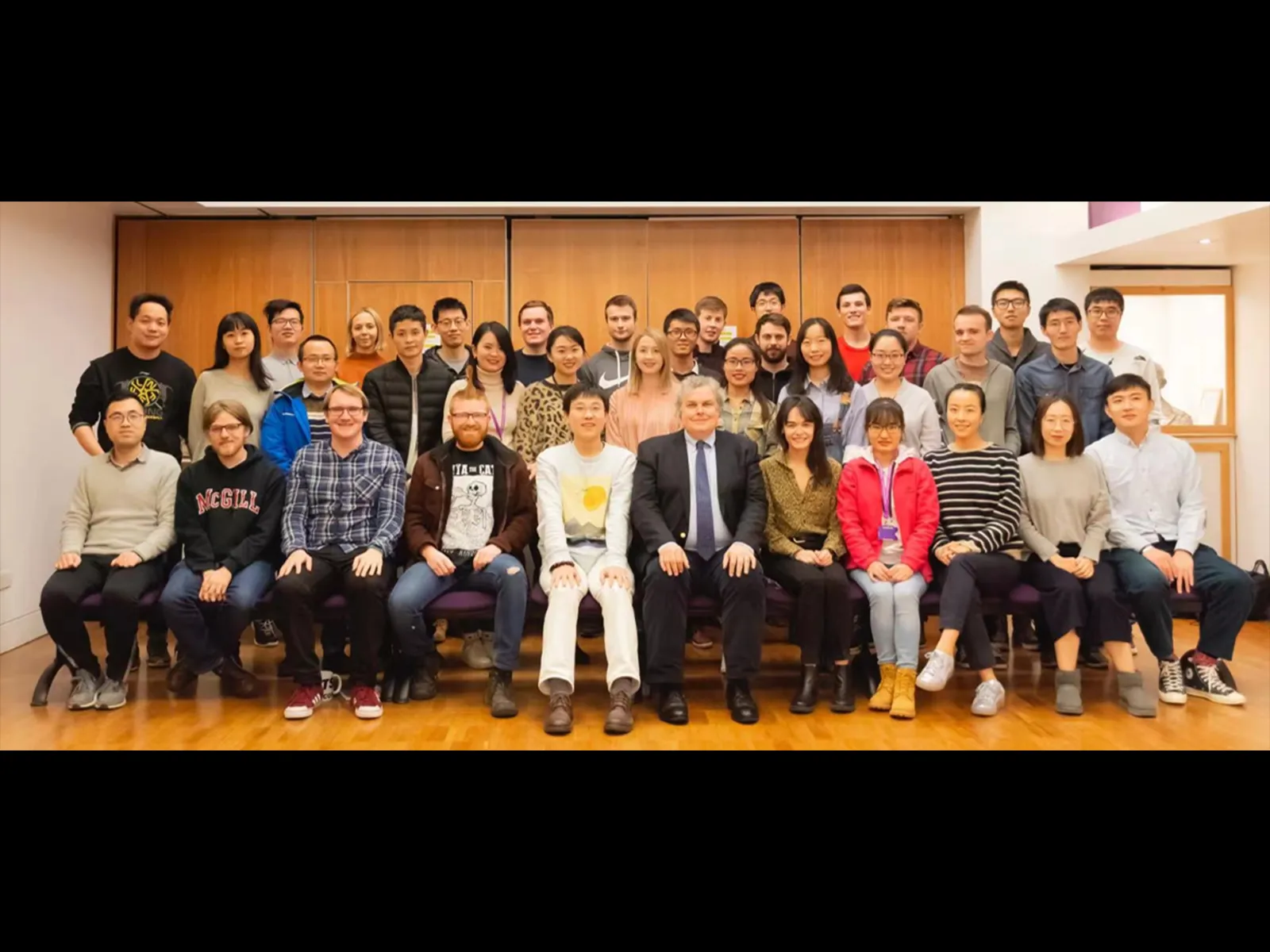Winner: 2024 Dalton Horizon Prize
Functional Framework Materials: Design and Characterisation Team
For seminal contributions to in situ and operando characterisation of porous materials and catalysts for the binding, capture and separation of fuels, hydrocarbons, and pollutants.

2024 Dalton Horizon Prize winner: Functional Framework Materials: Design and Characterisation Team
Functional Framework Materials: Design and Characterisation Team is a collaboration between the University of Manchester, Oak Ridge National Laboratory, Diamond Light Source, ISIS Neutron and Muon Source STFC, Berkeley Advanced Light Source, Peking University, Xiamen University and the University of Chicago.
Biography
Metal-organic frameworks (MOFs) are porous materials that can capture and store important fuels like hydrogen, methane, and ammonia, hydrocarbons (ethane, propane, and xylenes), and harmful pollutants (carbon dioxide, sulfur dioxide, and nitrogen dioxide).
Using state-of-the-art X-ray and neutron techniques, the team have been able to see the MOFs at the atomic level and how the captured molecules interact with the MOF’s internal structure during reactions. They also used computational modelling to give a deep understanding of how these advanced functional materials operate at a molecular level.
This extensive collaboration has been crucial for producing improved materials that can be integrated into our daily lives and makes a vital contribution towards solving the pressing climate and energy challenges that the world faces.
The team
Dr Bing An, The University of Manchester
Dr Sarayute Chansai, The University of Manchester
Dr Yongqiang Cheng, Oak Ridge National Laboratory
Dr Gianfelice Cinque, Diamond Light Source, Rutherford Appleton Laboratory
Dr Luke L Daemen, Oak Ridge National Laboratory
Dr Ivan da Silva, ISIS Neutron and Muon Source, STFC, Rutherford Appleton Laboratory
Dr Thien D Duong, The University of Manchester
Dr Mark D Frogley, Diamond Light Source, Rutherford Appleton Laboratory
Professor Sarah J Haigh, The University of Manchester
Dr Xue Han, The University of Manchester
Professor Christopher Hardacre, The University of Manchester
Dr Jack D Humby, The University of Manchester
Dr Daniel Lee, The University of Manchester
Dr Jiangnan Li, The University of Manchester
Weiyao Li, The University of Manchester
Dr Zhe Li, University of Chicago/Xiamen University
Professor Wenbin Lin, University of Chicago
Dr Yujie Ma, The University of Manchester
Dr Pascal Manuel, ISIS Neutron and Muon Source, STFC, Rutherford Appleton Laboratory
Professor Eric JL McInnes, The University of Manchester
Dr Louise Natrajan, The University of Manchester
Dr Marek Nikiel, The University of Manchester
Dr Timmy Ramirez-Cuesta, Oak Ridge National Laboratory
Dr Svemir Rudić, ISIS Neutron and Muon Source, STFC, Rutherford Appleton Laboratory
Dr Sergei A Sapchenko, TheUniversity of Manchester
Professor Martin Schröder, The University of Manchester
Dr Alena M Sheveleva, The University of Manchester
Professor Junliang Sun, Peking University
Dr Simon Teat, Advanced Light Source, Lawrence Berkeley National Lab
Dr Floriana Tuna, The University of Manchester
Dr Iñigo J. Vitórica-Yrezábal, The University of Manchester
Dr Cheng Wang, Xiamen University
Dr Zi Wang, The University of Manchester
Dr George Whitehead, The University of Manchester
Dr Shaojun Xu, The University of Manchester
Professor Sihai Yang, The University of Manchester
Dr Zhongyue Zhang, The University of Manchester
Xiangdi Zeng, The University of Manchester
Dr Yichao Zou, The University of Manchester
Q&A
What was your role within the team?
Eric McInnes: We used Electron Paramagnetic Resonance spectroscopy (EPR) to study processes involving radicals in the MOF materials. NO2 is a free radical, so we could follow its binding, mobility, and reactivity in the MOFs by EPR.
Yujie Ma: I was involved in the development of efficient reduction of NO2 over atomically dispersed copper sites on UiO-66 at room temperature.
Yongqiang Cheng: I was responsible for modelling, analyzing, and interpreting the inelastic neutron scattering data, which reveals the vibrational dynamics of the guest molecules and the host materials.
Xiangdi Zeng: I was primarily focused on the experimental aspects of the photocatalysis involving experiments for the photooxidation of methane to methanol and analysing the catalysis results.
Daniel Lee: I contributed through atomic-scale characterisation of structures and host-guest interactions using solid-state NMR spectroscopy.
Weiyao Li: I characterized various novel metal-organic framework materials, I was responsible for the planning, coordination and execution of various synchrotron neutron experiments carried out at ISIS.
Ivan da Silva: I analysed diverse powder diffraction datasets obtained from experiments conducted at X-ray synchrotron or neutron large-scale facilities. These datasets allowed identification of absorption sites within materials.
Pascal Manuel: I developed the powder neutron diffraction (PND) instrument and the methodology for the measurements.
Mark Frogley: I set up the in situ infrared microspectroscopy experiments at Diamond Light Source and was part of the team collecting and interpreting the data. I managed a project to develop novel sample environments compatible with aggressive gases as well as gas handling systems ensuring a high level of safety during the experiments.
What were the biggest challenges in this project?
Yujie Ma: The design and synthesis of sufficiently stable but active porous materials and the elucidation of their exact binding of substrates applied to the separation of fuels, hydrocarbons, and pollutants.
Jiangnan Li: The biggest challenges in this project involve developing materials that can withstand the corrosive properties of NO2 and SO2 and ensuring equipment design and maintenance procedures effectively mitigate the risk of material degradation.
Mark Frogley: Developing instruments and protocols to maximise the number, quality and range of experiments that can be performed in synchrotron visits (typically 4–6 days per six months). In early experiments, we were limited to a handful of samples and a few gases per experiment. Now, we routinely measure over 30 materials in around 70 experiments per visit with up to 9 gases, including highly aggressive ones like NO2.
What different strengths did different people bring to the team?
Bing An: Team members across many countries brought different strengths to the research in deep cooperation and collaboration across synthesis, characterisation, spectroscopy, diffraction and scattering, data analysis, modelling and mentorship.
Why is this work so important and exciting?
Timmy Ramirez-Cuesta: By looking at the dynamics of porous materials with and without substrates and by using advanced computational modelling, it is possible to determine how and why these materials perform in the way that they do.
Xiangdi Zeng: This work is important because it addresses a critical need to find sustainable and efficient ways to utilize and convert methane, a potent greenhouse gas, into more valuable chemicals like methanol, a 'holy grail' reaction in C1 chemistry.
Where do you see the biggest impact of this technology/research being?
Xue Han: By gaining deeper understanding of how these advanced porous materials function, we can make better sorbents for substrates, more active catalysts for various important chemical reactions, and develop commercially viable systems.
How will this work be used in real life applications?
Sarayute Chansai: This work will pave the way to better understanding and development of advanced functional materials and the chemical sciences, which can lead to scale-up and real-world applications and processes.
How do you see this work developing over the next few years, and what is next for this technology/research?
Ivan da Silva: In the years to come, our focus will shift toward scaling up the synthesis of these functional materials. This may involve exploring greener and more efficient synthesis routes. We aim to advance characterization techniques to enable in operando experiments under conditions that closely mimic real-world scenarios.
Pascal Manuel: The array of advanced characterization techniques we have put together to study these materials will be key as we move from in situ to more inoperando experimental conditions.
What inspires or motivates your team?
Zi Wang: Our team is always motivated by the excitement of exploring novel systems and materials. The opportunity to employ diverse techniques and methods of characterization in our research brings us together. This shared passion for discovery is what truly inspires us.
Yongqiang Cheng: Understanding how functional materials work at the atomic and molecular levels is the foundation of materials science. This motivates our research at the Spallation Neutron Source, which uses advanced neutron scattering and computer modelling to unravel the chemical processes and mechanisms inside porous materials.
What is the importance of collaboration in the chemical sciences?
Timmy Ramirez-Cuesta: Advances in science require collaboration. By forming a multidisciplinary team with diverse and complementary skills, it is possible to create a better and deeper understanding of materials and processes. The whole team is so much more than the sum of the individual contributions.
Daniel Lee: Collaboration brings together individual expertise where the whole is greater than the sum of its parts.
Pascal Manuel: We have used an array of various experimental techniques coupled with computational tools to push the limits of our understanding of these materials. This required many experts in their own field to pull together.
Mark Frogley: Working in a large collaboration has enabled a comprehensive understanding of these novel materials, which have been synthesized and characterized by multiple complementary techniques by highly expert colleagues. This approach provides a very robust understanding and gives so much extra insight into the chemistry of these materials.
What does good research culture look like or mean to you?
Zi Wang: To me, a good research culture is characterized by inclusivity, openness, and respect among all team members, regardless of their level of experience. Also, passion for continuous improvement and learning is essential, where every challenge can be considered as an opportunity to grow and innovate.
Xiangdi Zeng: A good research culture to me is one that supports curiosity, clear communication, team collaboration, and helps everyone grow professionally. It's about being ethical, safe, and understanding the wider importance of the research.
Daniel Lee: A good research culture is honest and open. This facilitates information exchange, speeding up progress, and helps others avoid mistakes that may have already been made.
Mark Frogley: Sharing as much information as possible, welcoming expert collaborators to help solve challenging problems, and giving everyone in the team an opportunity to discuss and contribute to all aspects of the work. That way, we all learn together.
How are the chemical sciences making the world a better place?
Yujie Ma: Chemical sciences can promote the development of advanced technologies to mitigate environmental pollutants, produce fuels in a sustainable way, and make the world a better place to live.
Alena Sheveleva: Materials science and chemistry are at the vanguard of addressing the myriad challenges that humanity must surmount for its sustainable existence. The pursuit of new novel materials for green catalysis and the adsorption and conversion of toxic gases is a top priority in our quest to improve the world.
What advice would you give to a young person considering a career in chemistry?
Eric McInnes: Go for it. If you are interested in what you are doing, then it is a very rewarding career.
Jiangnan Li: Explore different areas of chemistry to find your passion, and seek hands-on experience through internships and research projects to build practical skills and knowledge. Prioritize safety and ethical conduct in your work while staying resilient and open to continuous learning and adaptation.
Ivan da Silva: Researchers need to acquire foundational understanding of as many characterization techniques as possible. Familiarize themselves with the basics and grasp the valuable insights each technique can provide about their materials. By working together as a team you can gather all the necessary information without being an expert in every technique or facet of the work.
Mark Frogley: The world needs inquisitive people like you! With the skills that education or working in chemistry can give, you can make a real difference, and there are so many different areas where a good chemist can contribute.
Our winners
We are recognising individuals, collaborations and teams for their exceptional achievements in advancing the chemical sciences. Explore our prize winners, and discover and share their stories
Thank you to everybody who took the time to make a nomination this year, and to all of our volunteers on our judging panels.
